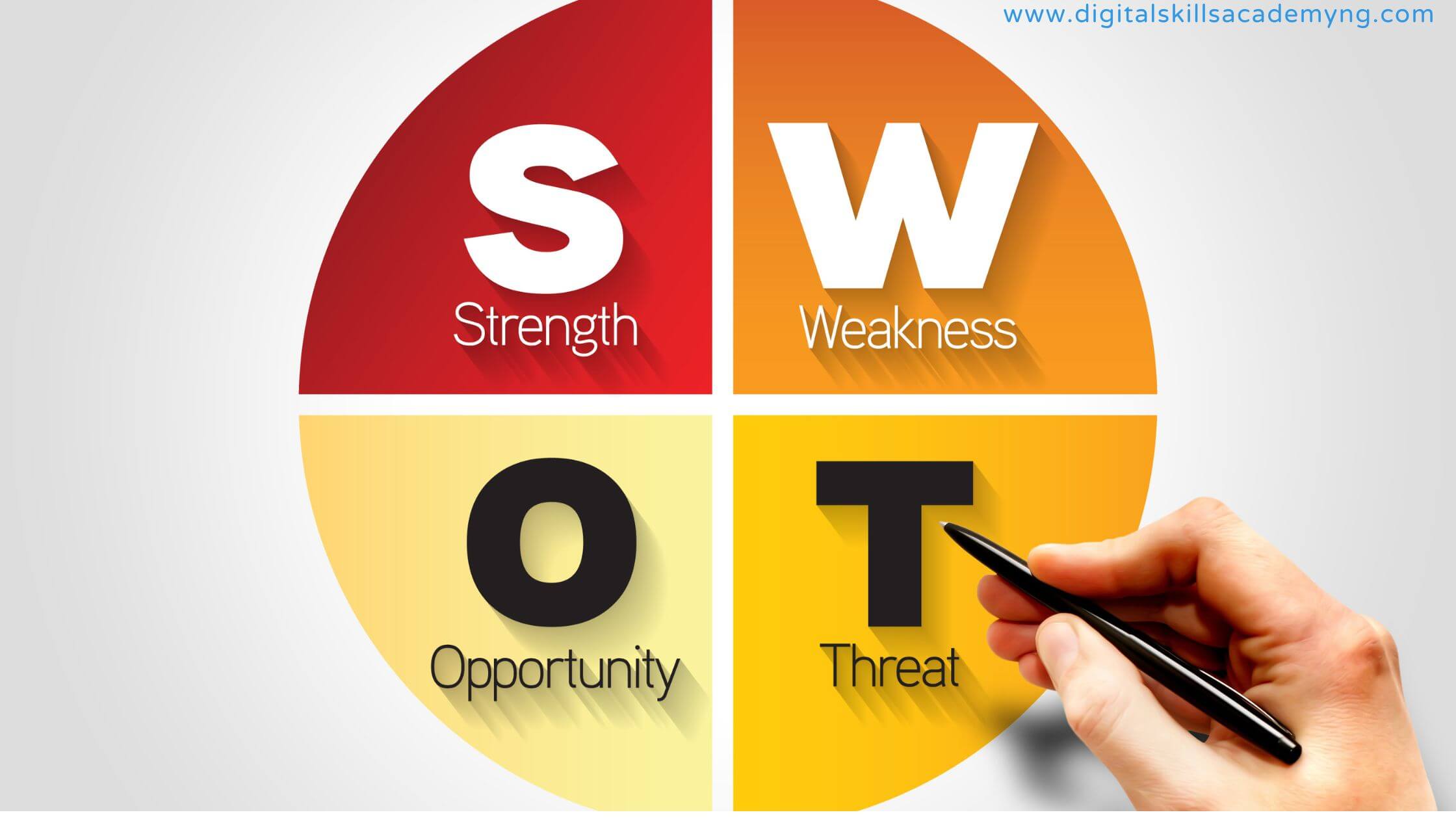A SWOT analysis is a powerful strategic tool used to identify and evaluate the Strengths, Weaknesses, Opportunities, and Threats involved in a business or an individual’s career.
This analytical framework provides a comprehensive view of internal and external factors influencing success and performance.
This blog post explains how to conduct a SWOT analysis for a business and an employee, provides examples, and looks into weaknesses within the SWOT framework.
What is a SWOT Analysis?
Table of Contents
A SWOT analysis is a structured method for assessing the key elements that affect an organization’s or individual’s performance.
The analysis is divided into four components:
- Strengths: Internal attributes that are beneficial and support achieving objectives.
- Weaknesses: Internal attributes that are detrimental and hinder achieving objectives.
- Opportunities: External factors the entity can exploit to its advantage.
- Threats: External factors that could cause trouble or pose challenges.
How to Conduct a SWOT Analysis for a Business
Step 1: Define the Objective
Begin by clearly defining the objective of the SWOT analysis. It could be a strategic decision, entering a new market, launching a new product, or improving overall business performance.
Step 2: Identify Strengths
List the internal strengths of the business.
These could include:
- Unique Selling Proposition (USP): What differentiates the business from competitors?
- Brand Reputation: A strong and positive brand image.
- Customer Loyalty: A dedicated and returning customer base.
- Financial Stability: Robust financial health and access to capital.
- Innovative Capabilities: Ability to innovate and adapt to market changes.
- Skilled Workforce: Highly skilled and motivated employees.
Step 3: Identify Weaknesses
Identify internal weaknesses that could impede business progress.
Examples include:
- Limited Resources: Insufficient financial, human, or technological resources.
- Poor Location: A less advantageous business location.
- Inefficient Processes: Inefficiencies in business operations.
- Weak Online Presence: Inadequate digital marketing and online engagement.
- High Employee Turnover: Difficulty in retaining skilled employees.
- Limited Product Range: A narrow range of products or services.
Step 4: Identify Opportunities
Examine external factors that the business can leverage.
Opportunities might include:
- Market Growth: Emerging markets or increased demand in existing markets.
- Technological Advancements: New technologies that can improve operations or product offerings.
- Strategic Partnerships: Potential collaborations with other businesses.
- Regulatory Changes: Favorable changes in laws or regulations.
- Customer Trends: Shifts in consumer behavior that the business can capitalize on.
Step 5: Identify Threats
Consider external threats that could challenge the business.
These might include:
- Economic Downturns: Economic instability or recessions.
- Competitive Pressure: Increased competition from existing or new players.
- Regulatory Changes: Unfavorable changes in laws or regulations.
- Technological Disruptions: New technologies that render current products or services obsolete.
- Market Saturation: Limited growth opportunities in a saturated market.
- Supplier Issues: Dependence on unreliable suppliers.
Step 6: Analyze and Develop Strategies
Use the insights from the SWOT analysis to develop strategies that leverage strengths, address weaknesses, capitalize on opportunities, and mitigate threats. This can involve:
- Strength-Opportunity (SO) Strategies: Use strengths to take advantage of opportunities.
- Weakness-Opportunity (WO) Strategies: Address weaknesses to exploit opportunities.
- Strength-Threat (ST) Strategies: Use strengths to mitigate threats.
- Weakness-Threat (WT) Strategies: Minimize weaknesses to avoid threats.
How to Conduct a SWOT Analysis for an Employee
Step 1: Define the Objective
Establish the purpose of the SWOT analysis. This could be for career development, performance improvement, or preparing for a new role.
Step 2: Identify Strengths
Identify personal strengths that contribute to the employee’s success. Examples include:
- Skills and Expertise: Specific technical or soft skills.
- Experience: Relevant work experience and accomplishments.
- Work Ethic: Strong commitment and dedication to work.
- Communication Skills: Effective verbal and written communication.
- Problem-Solving Ability: Capability to resolve issues efficiently.
- Adaptability: Flexibility in adapting to changes.
Step 3: Identify Weaknesses
Recognize personal weaknesses that could hinder career progress.
Examples include:
- Skill Gaps: Lack of necessary skills or knowledge.
- Time Management: Difficulty in managing time and meeting deadlines.
- Communication Barriers: Ineffective communication or language barriers.
- Procrastination: Tendency to delay tasks.
- Lack of Confidence: Low self-confidence affects performance.
- Resistance to Change: Reluctance to adapt to new situations.
Step 4: Identify Opportunities
Look for external opportunities for career growth.
These might include:
- Training Programs: Professional development courses are available.
- Networking: Opportunities to build professional relationships.
- Mentorship: Access to mentors who can provide guidance.
- Job Openings: New job positions within or outside the organization.
- Industry Trends: Emerging trends that can be leveraged for career advancement.
- Professional Associations: Membership in industry-related organizations.
Step 5: Identify Threats
Consider external threats that could impact career progression.
Examples include:
- Economic Conditions: Economic downturns affect job security.
- Industry Changes: Shifts in industry demand or practices.
- Competition: High competition for desired roles.
- Technological Advancements: Need to keep up with evolving technology.
- Organizational Changes: Restructuring or downsizing within the company.
- Performance Reviews: Negative feedback affecting career prospects.
Step 6: Analyze and Develop Strategies
Formulate strategies to leverage strengths, improve weaknesses, capitalize on opportunities, and mitigate threats.
This could involve:
- Strength-Opportunity (SO) Strategies: Use personal strengths to seize opportunities.
- Weakness-Opportunity (WO) Strategies: Address weaknesses to exploit opportunities.
- Strength-Threat (ST) Strategies: Use strengths to mitigate threats.
- Weakness-Threat (WT) Strategies: Minimize weaknesses to avoid threats.
SWOT Analysis Examples
Example 1: Business SWOT Analysis
Objective: Launch a new product in the market.
Strengths:
- Strong brand reputation.
- Established distribution network.
- Innovative product features.
- Skilled marketing team.
Weaknesses:
- High production costs.
- Limited market research data.
- Dependence on a single supplier.
- Inflexible supply chain.
Opportunities:
- Growing market demand.
- Potential partnerships with influencers.
- Favourable government policies.
- Advances in production technology.
Threats:
- Intense competition.
- Economic uncertainty.
- Changing consumer preferences.
- Regulatory challenges.
Example 2: Employee SWOT Analysis
Objective: Prepare for a leadership role.
Strengths:
- Excellent communication skills.
- Proven leadership experience.
- Strong problem-solving abilities.
- High emotional intelligence.
Weaknesses:
- Limited technical expertise.
- Difficulty delegating tasks.
- Tendency to avoid conflict.
- Public speaking anxiety.
Opportunities:
- Leadership training programs.
- Networking events with senior leaders.
- Access to a mentorship program.
- Opportunities to lead cross-functional teams.
Threats:
- High competition for leadership roles.
- Organizational restructuring.
- Rapid technological changes.
- Economic downturns affecting promotions.
Understanding Weaknesses in a SWOT Analysis
Weaknesses in a SWOT analysis represent internal factors that can hinder progress and performance.
The organization or individual needs improvement to achieve their goals in these areas. Identifying weaknesses is crucial for developing effective strategies to overcome challenges and leverage strengths.
Common Weaknesses in Business
- Lack of Resources: Insufficient financial, human, or technological resources can impede growth and efficiency.
- Inefficiencies: Inefficient processes and workflows can lead to higher costs and reduced productivity.
- Weak Brand Presence: A weak brand presence can limit market reach and customer loyalty.
- Poor Location: A disadvantageous business location can affect accessibility and visibility.
- Limited Product Range: A narrow product range can restrict market opportunities and customer choices.
- High Employee Turnover: Frequent employee turnover can lead to loss of knowledge and increased hiring costs.
Common Weaknesses in Employees
- Skill Gaps: Lack of necessary skills or knowledge can affect job performance and career progression.
- Time Management Issues: Poor time management can lead to missed deadlines and lower productivity.
- Communication Barriers: Ineffective communication can cause misunderstandings and reduce teamwork efficiency.
- Procrastination: Delaying tasks can result in rushed work and lower-quality output.
- Lack of Confidence: Low self-confidence can hinder decision-making and assertiveness.
- Resistance to Change: Reluctance to adapt to new situations can limit growth and innovation.
Addressing Weaknesses
To address weaknesses effectively, consider the following strategies:
- Training and Development: Invest in training programs to build skills and knowledge.
- Process Improvement: Streamline processes to enhance efficiency and reduce costs.
- Resource Allocation: Optimize resource allocation to ensure adequate support for critical areas.
- Brand Enhancement: Strengthen brand presence through marketing and customer engagement.
- Product Diversification: Expand the product range to meet diverse customer needs.
- Employee Retention: Implement strategies to improve employee satisfaction and reduce turnover.
What We Say
Conducting a SWOT analysis is a valuable exercise for both businesses and employees. It provides a clear understanding of internal strengths and weaknesses, as well as external opportunities and threats. By leveraging strengths, addressing weaknesses, capitalizing on opportunities, and mitigating threats, businesses and individuals can develop effective strategies for success and growth.
Whether you are a business leader looking to improve your organization’s performance or an employee aiming to advance your career, a well-executed SWOT analysis can guide you toward achieving your goals and overcoming challenges.
Our certified Digital marketing course will teach you how to perform customer and business research, provide customer service strategies, develop a customer retention plan, and research all the key marketing channels to leverage them to engage your customers and grow your business. What are you waiting for?




